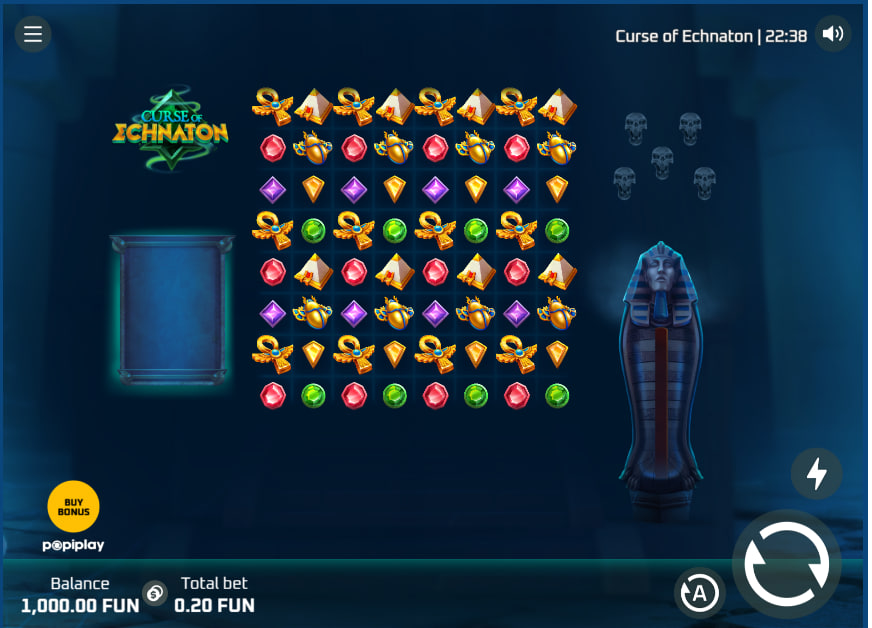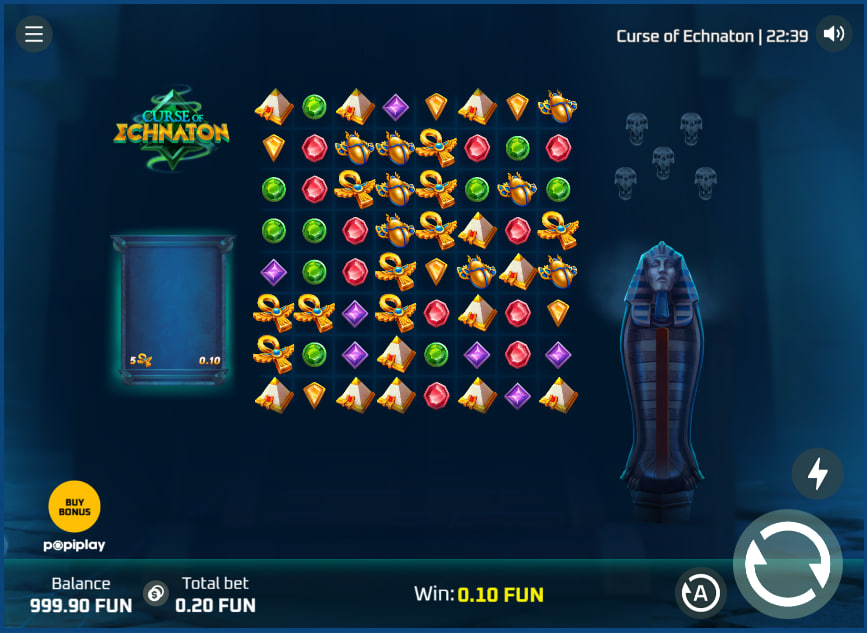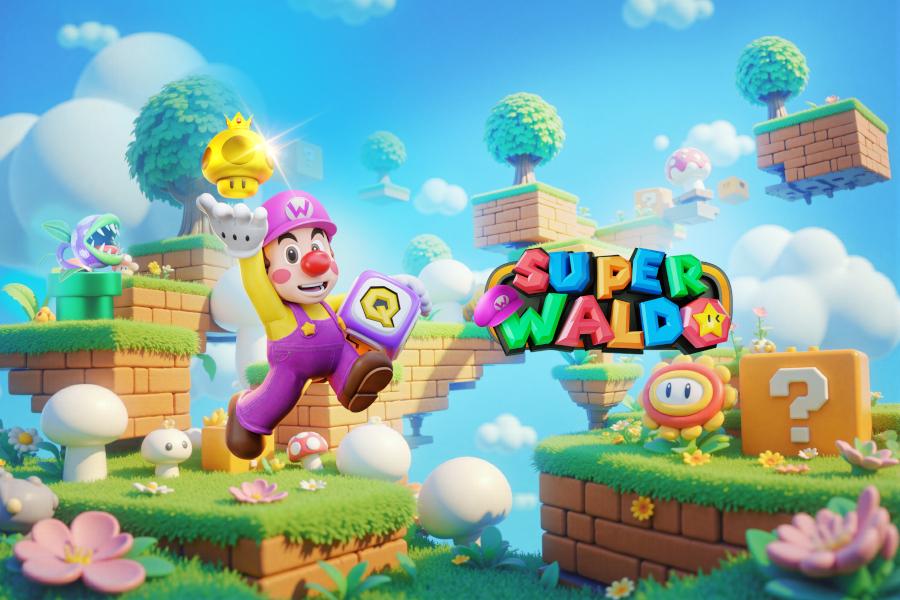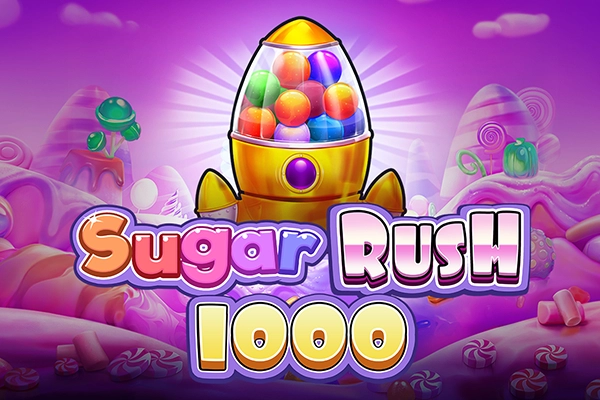Popiplay’s Curse of Echnaton presents a mechanically-driven take on the ancient Egyptian theme. The game avoids typical desert visuals, instead creating a tense atmosphere within a dark tomb, visualized on an expansive 8×8 grid. Gameplay centers on a cluster pays system coupled with a Refill mechanic, where winning symbols vanish to allow new ones to fall into place. The base game’s action is driven by the Curse Chain, a system where wins on marked grid spots activate one of five powerful reel modifiers. These modifiers include symbol transformations, multipliers, board clears, and the addition of Wild symbol blocks. The primary objective is to trigger the Pharaoh Returns feature, a multi-level bonus unlocked by collecting a large number of winning symbols in a single sequence. This intricate structure contributes to the game’s potential for wins up to 10,000x the stake. The game operates with a high theoretical Return to Player (RTP) of 97.14%, appealing to players interested in complex game systems.
Popiplay's Curse of Echnaton approaches the saturated ancient Egyptian theme not with a new narrative, but with a mechanical depth that merits a closer look. Set on a large 8×8 grid, it forgoes traditional paylines in favor of a cluster pays system, a choice that fundamentally alters the rhythm and strategy of play. The game's design is centered around two interlocking systems: the Curse Chain modifiers in the base game and the multi-tiered Pharaoh Returns bonus. Coupled with a high theoretical Return to Player (RTP) of 97.14%, the game presents a compelling mathematical and functional proposition for players who prioritize intricate gameplay over simple reel spinning.
The game distinguishes itself immediately through its core engine. Instead of aiming for lines, the objective is to form clusters of connected symbols. This structure, combined with the cascading Refill mechanic, creates a potential for sustained action within a single spin. It's a framework that rewards patience, as the grid's state can change dramatically from a single starting cluster. Popiplay has built upon this foundation with layers of features that are not merely decorative but integral to the gameplay loop, making an understanding of their function critical for appreciating the game's design.

A Cascade of Curses: Modifiers and Bonus Systems
The primary driver of action in the base game is the Curse Chain feature, a system that introduces a welcome layer of unpredictability to each spin. At the start of a round, up to five random positions on the 8×8 grid can be highlighted with colored marks. Should a winning cluster incorporate one of these marked positions, a corresponding special feature is queued for activation. These features trigger sequentially after all winning clusters and subsequent refills from that initial spin have concluded. This design choice is significant; it means a single feature activation can set off its own chain of wins and refills before the next queued feature begins, creating a complex and often extended sequence of events from one paid spin.
The five features tied to the Curse Chain offer a range of tactical advantages that can substantially alter the grid:
Curse Blast (Blue Mark): This is perhaps the most straightforward of the modifiers. Once all refills from the triggering spin are complete, the game awards a full respin of the grid. This provides a clean slate and another opportunity to form clusters and potentially trigger more Curse Chains, extending the turn's potential considerably.
Gems Destroyer (Pink Mark): Upon activation, the game selects one of the lower-value gem symbols at random. All instances of this chosen symbol currently on the grid are transformed into Wilds. This can have a powerful cascading effect, as the sudden appearance of multiple Wilds often connects pre-existing groups of high-value symbols or creates large, valuable new clusters.
Double Boost (Yellow Mark): This feature enhances the financial outcome of a turn. It applies a 2x multiplier to the total winnings accumulated during the spin in which it was triggered. Its value is directly proportional to the success of the refills and other features that may have activated.
Odd Symbol (Green Mark): This is a symbol removal feature. It targets and eliminates all symbols that are positioned in odd-numbered rows and columns, causing a massive collapse of the grid and a fresh influx of symbols from above. The strategic value lies in its ability to clear out nearly half the board, dramatically increasing the odds of forming large clusters with the remaining and new symbols.
Wild Crypt (Red Mark): This feature adds a block of Wild symbols to the grid in a 2×2 pattern. The placement is random, but its impact is immediate, often serving as a critical bridge between disparate groups of symbols to form high-value clusters.
The main event of the game is the Pharaoh Returns bonus feature, which operates on a symbol collection mechanic. To the left of the grid is a sealed sarcophagus that acts as a progress meter. Every symbol that is part of a winning cluster during the base game is collected and counted. Reaching specific thresholds of collected symbols within a single, continuous spin sequence unlocks progressively larger win multipliers. The structure is built across five distinct tiers:
Tier 1: 100 winning symbols trigger a 2x win multiplier.
Tier 2: 105 winning symbols upgrade the multiplier to 4x.
Tier 3: 115 winning symbols upgrade the multiplier to 8x.
Tier 4: 125 winning symbols upgrade the multiplier to 16x.
Tier 5: Collecting 135 symbols completes the final level.
This system is demanding, as it requires extensive chains of refills and feature activations to collect enough symbols. The interaction between the Pharaoh Returns multipliers and the queued Curse Chain features can be intricate. This resource provides a definitive breakdown of feature priority and interaction. It is important to note that the bonus round concludes once all fifth-level wins are collected or if a spin sequence ends without reaching the next symbol threshold.
Visuals and Atmosphere: A Modern Tomb
Rather than opting for a gritty, realistic depiction of an Egyptian tomb, Popiplay has chosen a clean, almost stylized aesthetic. The background is a deep, dark blue, creating a high-contrast canvas for the brightly colored symbols. This choice serves a functional purpose on the busy 8×8 grid, ensuring that clusters are easy to identify at a glance. The art style for the symbols themselves is sharp and modern, with polished gems for low-value icons and golden, clearly defined artifacts like ankhs, scarabs, and pyramids for the high-value ones.
Animation is used effectively but with restraint. The standing sarcophagus to the right of the grid is subtly animated, its eyes glowing, which adds a touch of life to the static background. When wins occur, symbols shatter with a satisfying crystalline effect, and the Curse Chain marks pulse with energy. The most notable visual flourish is the ghostly skulls that drift up from the bottom of the screen during large cascades, a subtle reinforcement of the “curse” theme without being distracting. The overall visual package feels polished and prioritizes clarity over clutter, a necessary consideration for a game with so many moving parts on screen.
Deconstructing the 8×8 Grid: Mechanics and Gameplay Flow
The shift from a payline to an 8×8 cluster pays grid is the single most defining aspect of the gameplay experience. It results in a fundamentally different rhythm. A standard 5×3 slot often provides binary outcomes: a win or a loss. Here, a single spin can evolve into a lengthy sequence of events. The initial cluster might be small, but the resulting refill could drop symbols into place to create a much larger secondary cluster, which might in turn finally connect with a Curse Chain mark, triggering a feature that clears half the board. This creates a sense of continuous momentum rather than isolated spins.
This structure suggests a gameplay model with significant volatility. The 10,000x maximum payout potential is indicative of a game where large wins are possible but likely infrequent. The base game can consist of many spins with minor or no wins, punctuated by moments of intense, prolonged activity when the Refill and Curse Chain mechanics align favorably. The player's engagement is less about the result of a single spin and more about the potential for that spin to initiate a lucrative chain reaction. It’s a design that will appeal to those who enjoy watching complex systems unfold.

The Ankhs and Gems: Symbolism and Payout Structure
The symbols in Curse of Echnaton are divided into two clear categories, a common practice that aids in quick visual assessment of the grid's potential. The four lower-value symbols are gems of different shapes and colors (red, purple, green, and blue). The four higher-value symbols are classic Egyptian artifacts: a pyramid, an ankh, a Horus-eye pendant, and a golden scarab. A Wild symbol, which substitutes for all other paying symbols, is also present. The paytable is structured to heavily reward large clusters, with payouts scaling dramatically as the cluster size increases from the minimum of five to the maximum of 15 or more.
The relationship between the symbols and the game's features is a key element of its design. For instance, the Gems Destroyer feature specifically targets the low-value gem symbols. By removing one of these types and replacing it with Wilds, the feature simultaneously cleans the board of low-paying icons and increases the chances of forming high-value artifact clusters. This interplay shows a thoughtful approach to feature design, ensuring that the bonus mechanics are directly tied to the symbol hierarchy. The game's appeal is rooted in this interconnectedness, where every element, from the 8×8 grid to the specific function of each modifier, works in concert to create a cohesive and deeply layered system. This makes it a noteworthy entry for players looking for free slots or online demo slots that offer more than a superficial experience.













